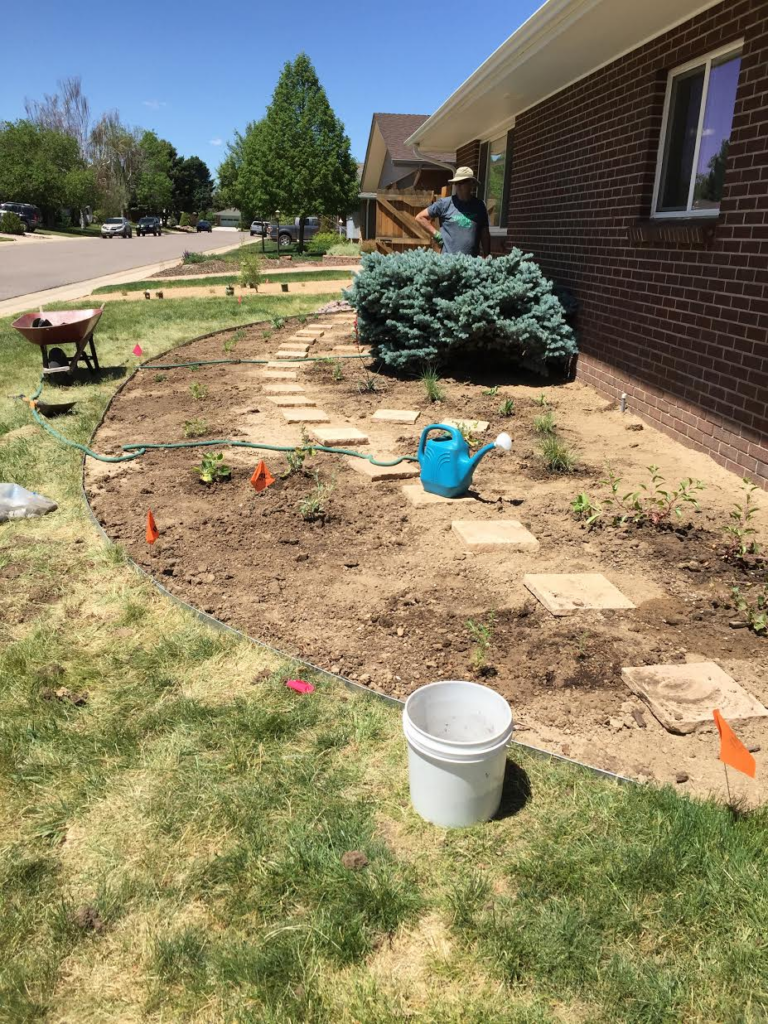by Ann Winslow
Inspired by Douglas Tallamy’s book Bringing Nature Home (subject of the Wild Ones Book Club in January), this spring I decided to create a native plant pollinator garden in my 1960s suburban Denver yard. It was my first adventure in using all native plants.
Most yards in my neighborhood are primarily turf and evergreens with some popular but non-native blooming shrubs or perennials. As Dr. Tallamy explains, these are inadequate in providing food and shelter for our native pollinator friends at their various life stages.

Being the new neighbor on my block, I wanted to showcase a native pollinator habitat that was beautiful and naturalistic without looking “wild” – a common complaint from suburbanites about native plant gardens. The Habitat Network and National Wildlife Federation websites gave me tips on how habitat gardens can fit in a typical suburban landscape.
My prospective garden site was the south-facing side yard between my house and the street — a long, narrow space that resembled a landing strip. Given my budget and labor availability (my spouse and me), I decided to simply enlarge an existing foundation bed into a half-oval shape twice its original size. I also decided to use sandstone pavers as stepping stones through the new garden giving it some hardscape interest as well as a place to stand and hand-water plants without stepping on and compacting the soil.

“Beginning “
Then I went online and looked at specific examples of garden and plant designs on the websites of Plant Select, the Colorado Native Plant Society (CoNPS), and Resource Central. These gave me ideas for shape, dimensions, and plant placement. From there, it was on to plant selection remembering the cardinal rule of “right plant, right place”.
These were my criteria in researching native plants:
- Food and/or shelter for pollinators
- Tolerant of clay soil
- Thrive in hot, dry, southern exposure
- Low water needs
- Waves of color from spring to fall
- Minimally aggressive
- Height and width
To keep to a more traditional suburban design, I wanted taller plants at the back near the house and shorter plants toward the front of the bed with a focus on perennials and grasses. Rather than having large swaths of a few colors, I decided on a multicolor palette using 3-5 plants each of about 12 diverse species. I looked at several websites for plant information – CoNPS, CSU Extension, and City of Boulder primarily. Two of these sites also had a list of native plant retailers.
Using my plant criteria and projected garden dimensions, I created a spreadsheet as my buying guide. I ordered plants online during the shelter-in-place order and picked them up curbside the following month. I made several trips to Harlequin’s Gardens to buy natives that I knew were neonicotinoid-free (neonicotinoids are systemic pesticides used by many plant nurseries). At a couple of other retail nurseries, I verified with the staff that the plants I purchased had been grown without neonicotinoids.

Here’s what I bought in each color family.
Yellows: Chocolate Flower (Berlandiera lyrata), Black-Eyed Susan (Rudbeckia hirta), Stiff Goldenrod (Solidago rigida), Rocky Mountain Zinnia (Zinnia grandiflora)
Reds: Sunset Hyssop or Licorice Mint (Agastache rupestris), Winecups or Purple Poppy Mallow (Callirhoe involucrata), Red Yucca (Hesperaloe parviflora), Colorado or Desert Four O’Clock (Mirabilis multiflora), Desert Beardtongue (Penstemon pseudospectabilis), Prairie Coneflower (Ratibida columnifera), Autumn Sage (Salvia gregii)
Blues: Dotted Gayfeather (Liatris punctata), Blue Flax (Linum lewisii), Tansy Aster (Machaeranthea tanacetifolia)
Two grasses, Blue Grama (Bouteloua gracilis) and Little Bluestem (Schizachyrium scoparium), added green/yellow and blue/green to the palette.
Before planting the bed, we removed struggling non-native shrubs and turf. Given that our native plants generally don’t do well in rich soil (becoming leggy with fewer blooms and shorter life), I didn’t amend the clay soil other than to add a tablespoon of expanded shale to the dirt of the planting hole. And that was only for a couple of species like Red Yucca (a regional native) that prefer somewhat rocky soil or good drainage. I mulched with 3” of pea gravel after learning that xeric plants often prefer that over wood chips.

From June to mid-July, I hand-watered the plants almost daily since I didn’t want to install a drip system. Many of the plants doubled in size. A few, such as the Chocolate Flower, actually bloomed profusely throughout the season. I reduced the watering to twice a week and then to once a week until hard frost. If the drought continues through winter, I’ll water once a month. By next year, they shouldn’t need any additional water except occasionally during a severe drought period.

A couple of lessons learned so far: 1) design-wise, a garden habitat needs height and visual weight to complement grasses and perennials, so I’m adding a native deciduous shrub — plus it creates more habitat; and 2) irrigation overspray from adjoining turf can negatively affect native plants that like dry conditions. We spent a lot of time adjusting the in-ground lawn sprinklers. It will get easier as we continue to reduce the turf by at least 60%.
I’m happy with my new native plant pollinator habitat. Already, several neighbors have complimented it. Seeing all sorts of bees on the blooming plants was thrilling – just what I had wanted! That success has motivated me to create more habitats in my yard next year and hopefully inspire my neighbors to add native plants to theirs.
Curious to learn more about transforming your garden into a habitat with Colorado native wildflowers, grasses, shrubs, and trees? Check out our native gardening toolkit, register for an upcoming event, subscribe to our newsletter, and/or become a member – if you’re not one already!
